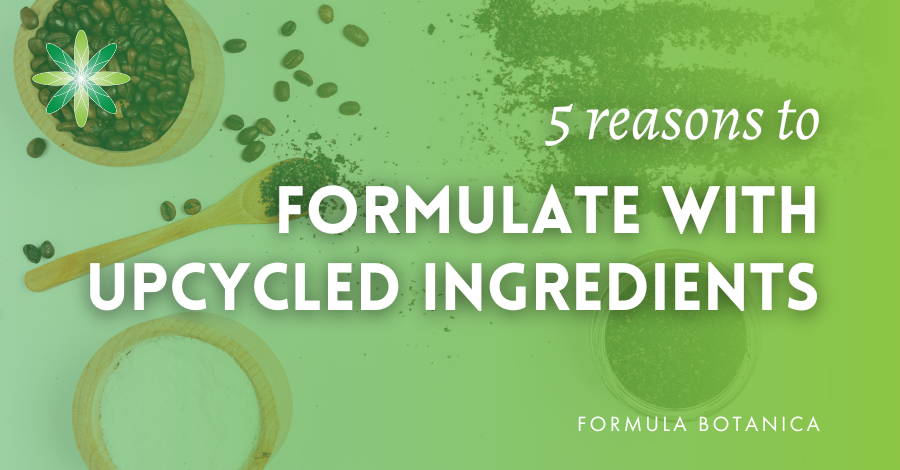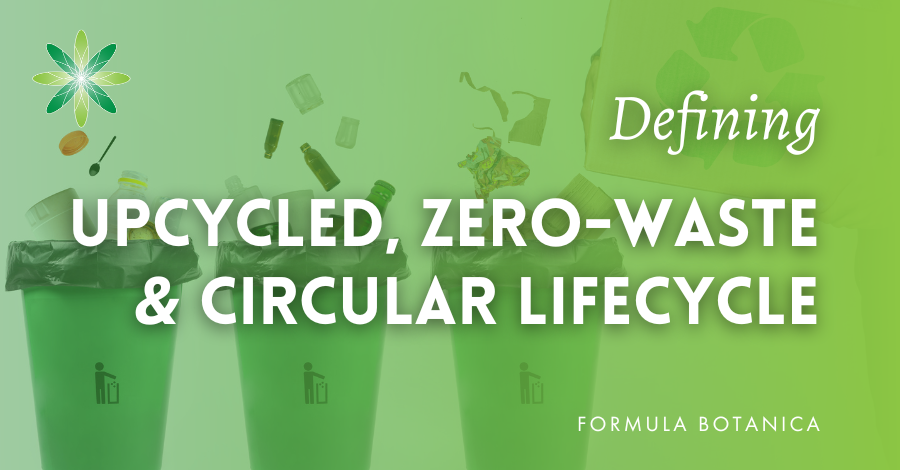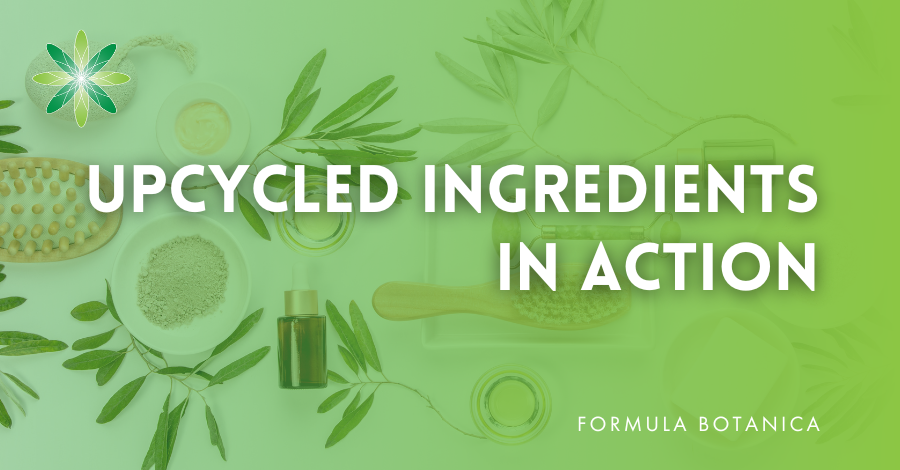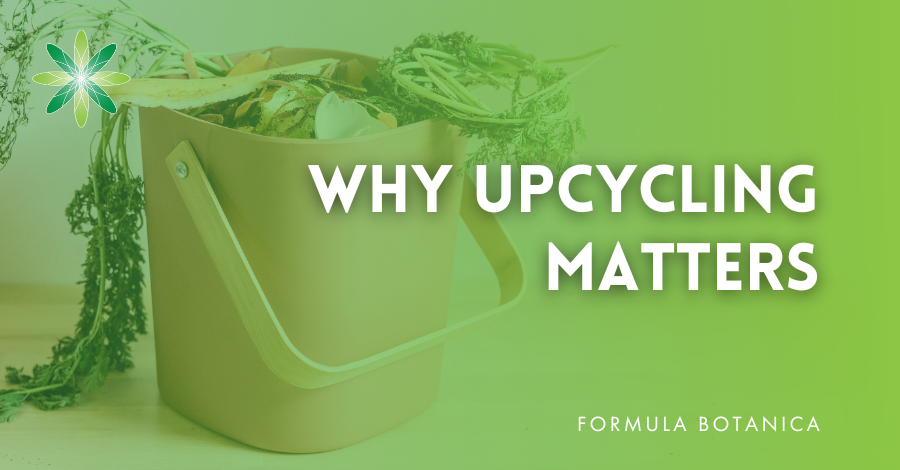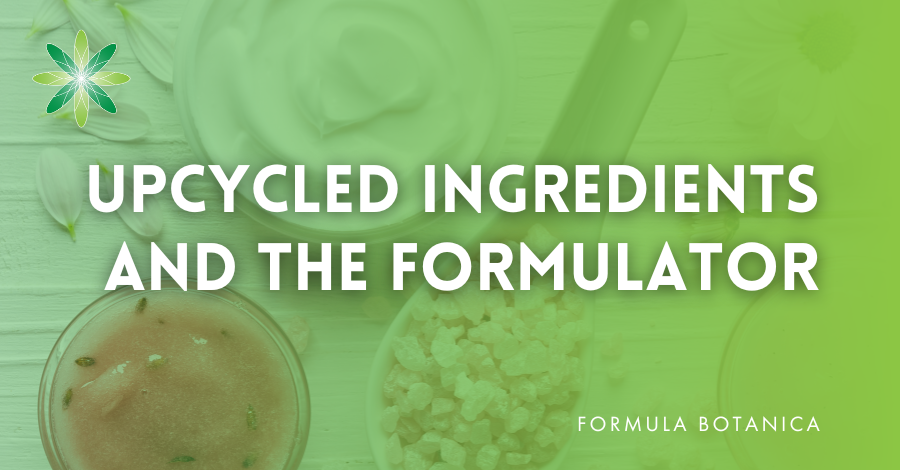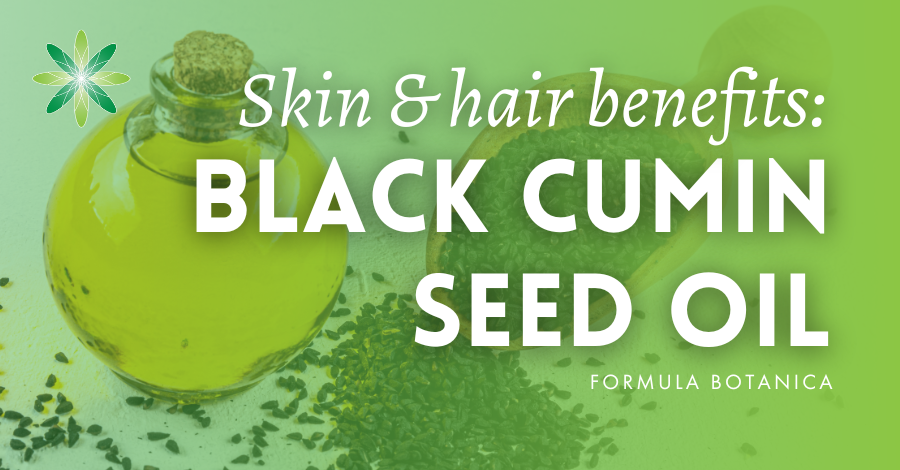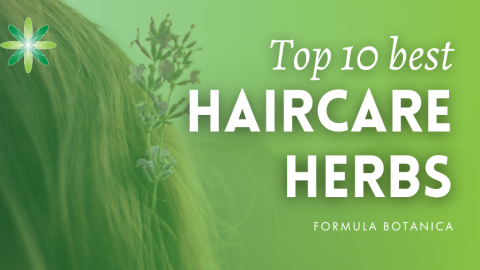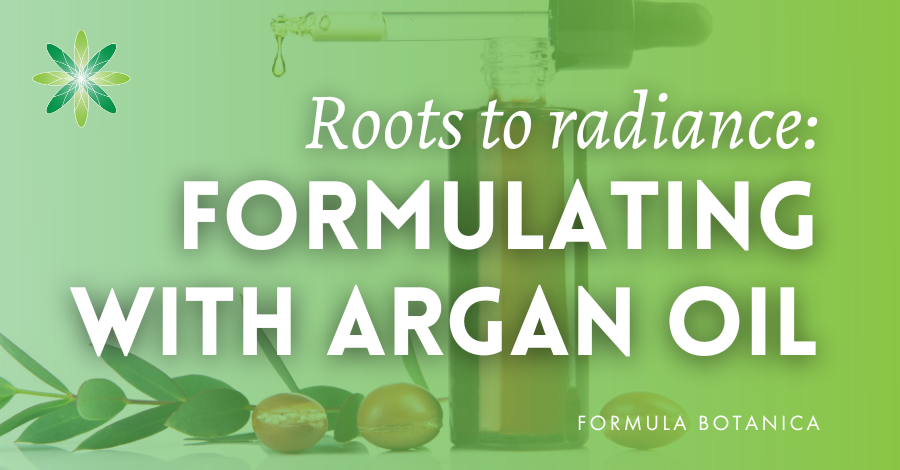Would you know the difference between upcycled and zero-waste cosmetic ingredients? If you are confused by the plethora of terms used today to categorise and certify various cosmetic ingredients and finished products, then you are not alone.
Since we launched our Green Beauty Conversations podcast at Formula Botanica, we have used the platform to unpack and demystify the top and trending sustainability terms that are circulating in the beauty industry.
Browse our episode library and you will find we have covered topics on sustainability ranging from the rise of solid cosmetics and the myth of waterless beauty to plastic-free, carbon-neutral, carbon-negative, net-zero, climate-neutral, upcycled and blue, green, clean, natural, transparent and any number of other ways to achieve a more sustainable beauty industry.
It is upcycling that we focus on in this blog post. Why? Because upcycling is a natural companion to organic formulation. As natural formulators, loving and working with plants and their extracts, it should be second nature for us to seek to use cosmetic ingredients created from left-over, otherwise wasted plant matter.
First, let’s define upcycling.
Upcycling vs zero waste vs circular economy: definitions
Zero waste literally means creating no waste in the life cycle of your beauty product. It implies that from field to face and from farm to manufacturer, whether the home formulation lab or an outsourced entity, your beauty product and its ingredients are not producing waste or are being recouped rather than going to waste.
This concept overlaps with the cradle-to-cradle or the closed-loop (circular) economy in which all resources used in the manufacturing process and in the products themselves are retained and returned to the cycle. This is in contrast to the linear life cycle of materials and products which sees them disposed of as waste at the end of their useful life. For more on these concepts, see:
Podcast 20: Zeroing in on zero waste in green beauty
15 certification schemes for sustainable beauty
Podcast 66: What is circular beauty?
Upcycling, however, uses waste by-products to turn them into products of greater material value. Think of it rather like buying an item from a junk shop and turning it into something amazing for your home.
Upcycling interlinks with zero-waste and the closed-loop economy by re-purposing waste from other processes and thereby keeping that waste in circulation. Upcycling helps reduce the waste mountain. At the end of its life, an upcycled product is not necessarily retained for onward use in the circular economy. It is worth stressing that it is impossible for cosmetics to comply fully with the theory of the circular economy as cosmetics themselves are washed off, evaporate, are absorbed by the skin or dumped in the waste bin.
Upcycled ingredients are the next big thing in cosmetics. @FormulaBotanica guide explains what are they and why the natural formulator should use them. #upcycledingredients #cosmeticingredients #naturalformulation Share on XUpcycled ingredients in action
A good example of upcycling in action in cosmetics would be exfoliant body scrubs containing waste coffee grounds or powdered rosehips or hibiscus seeds which are treated and made safe for cosmetic use.
One indie beauty company that has built a global business from upcycling, starting with coffee grounds, is Upcircle, whose co-founder Anna Brightman we interviewed on our podcast.
Upcircle now uses more than coffee grounds and has developed a whole range of personal care founded on upcycling waste by-products of the food and drink industry. Other key sources of upcycled ingredients it includes come from the citrus juice and botanical oil industries. As Anna explains, upcycling takes research, patience, trial and error and investment if you are starting from scratch in sourcing directly from food and drink industries.
With many upcycled ingredients available for cosmetics from retail suppliers, you can quite easily find some to suit your formulations. The challenge comes in seeking out more unusual or new-on-the-market upcycled ingredients that can give your formulations an edge.
Plus, you will need to ask for documentation of the ingredient so you can follow its paper trail and be sure it is cosmetic grade and also genuinely an upcycled material. If you intend your brand or cosmetic products to be certified organic, for example, you will need to be diligent in tracking down the origins of any upcycled ingredients you wish to include. Even if grown to organic-certified standards, the plant by-product may not have been processed in a way that complies with organic certification.
Upcycled ingredients are such a vast and interesting topic for the natural formulator to explore that our membership site, The Lab at Formula Botanica, has dedicated an entire training module – or Mini Lab – to them. The Lab provides a deep dive into formulating with upcycled ingredients and details on the cosmetic benefits of some key, trending upcycled materials. Pre-register to join the Lab when it next opens for membership and discover more about upcycled ingredients and gain access to its library of training on other specialist formulation topics.
Why upcycling matters
The beauty and personal care industry, as a sector worth half-a-trillion US$ a year, has a responsibility to help conserve and replenish the planet’s natural resources for future generations. As such a global economic force, the industry is a vast consumer itself, as well as promoter of consumption. With the average beauty consumer having around 16 products on the go at any one time, you can begin to see how we love to consume beauty products.
Formula Botanica CEO Lorraine Dallmeier makes this point in her manifesto: four pillars of sustainable beauty. In her opinion podcast, Lorraine highlights the need for the beauty sector to reduce its growth and consumption – even if this is an anathema to big personal care businesses – if it is serious about being a more sustainable industry.
It is heartening to see that the indie and natural beauty sector has often shown itself most responsive in driving sustainable practices with individual founder-CEOs having the conviction and agility to act fast. We have seen some creative, enterprising ideas for promoting sustainable business come from small beauty brands. We have interviewed founders who have pioneered innovative bulk refilling schemes, and “refill, return, repeat” options with durable containers as well as the upcycling of ingredients.
According to the Upcycled Food Association, over 30% of all food produced globally is lost or goes to waste yet 60% of people want to buy more upcycled food products, and that’s because 95% of us want to do our part to reduce food waste. The scope for researching and developing innovative cosmetic ingredients from waste such as discarded peel, pips, pith, leaves, stems, husks, shells, kernels, bark, rind, misshapen or so-called ugly fruit and vegetables, and more is therefore enormous.
Luckily for us, research and development is going into finding cosmetic ingredient gems in the organic garbage of industries such as food and drink.
Upcycled ingredients and the natural formulator
There are many reasons why as natural formulators we should look to use upcycled ingredients. Obviously, by using by-products we are reducing demand for the growing, harvesting and processing, as well as the packaging of new crops of botanicals as cosmetic ingredients. Mono-crops for use in the cosmetics’ industry can be considered resource heavy to produce and bad for biodiversity. Rose essential oils, for example, can be viewed as unsustainable to produce as it takes an average of 5 tons of petals to create approximately 1kg of oil. But even in rose oil production, upcycling research is taking place.
With climate change putting pressure on viable agricultural land worldwide, food crops are a priority. The United Nations predicts the world will need a 50% increase in food production over 2010 levels in order to feed the estimated 9.3 billion people on the planet by 2050.
According to the US Environmental Protection Agency, food waste accounts for approximately 6% of human-caused greenhouse gas emissions and there are further startling figures and informative background reading in the US Department of Agriculture’s report From Farm to Kitchen: the Environmental Impacts of Food Waste.
If the processing of tomato or grape pips or olive pumice waste, for example, into cosmetic ingredients removes organic waste that would otherwise decompose in land fill to release greenhouses gases and affect climate change, then the beauty industry should be doing what it can to support upcycling. Energy, water and other resources are used in upcycling ingredients, but their processing can be carried out in line with sustainability practices. When sourcing upcycled ingredients, you will need to do thorough research to track their route and the ethics of their production from farm to supplier.
As you can see, nothing is ever that simple and straightforward in aiming to formulate more sustainable beauty products, but we encourage you to embrace the challenge. After all, there are many good reasons to love upcycled ingredients whether as a formulator, a small indie brand or a beauty consumer.
Let’s round up with a recap of why the natural formulator should love upcycled ingredients.
5 reasons to love upcycled cosmetic ingredients
1. They are a more sustainable option
Created from organic waste by-products, upcycled cosmetic ingredients can reduce waste from other industries (mainly the food and drink). This waste would otherwise decompose in landfill or be incinerated thereby producing greenhouse gas emissions that affect climate change. Upcycled ingredients reduce too the need to harvest and process fresh botanicals that are grown on land that could be put to much-needed food crop production.
2. They can differentiate your formulations
Upcycled ingredients can be the star or hero ingredients in your formulations and as such, highlight your drive to create more sustainable skincare or haircare. Keep abreast of what is happening in cosmetic science research and on your supplier websites to discover innovative, new upcycled ingredients. Discover how you can harness their potential in your formulations.
3. They can be a big part of your branding and messaging
Using upcycled ingredients in cosmetics is still a new concept, especially for consumers. There might be scepticism about the efficacy and desirability of using by-product, ‘waste’ materials in cosmetics. But, this means there is scope for indie beauty brands to educate their customers and make their own market by explaining how and why they use certain upcycled ingredients.
4. They can help promote local businesses
Look around at what food is produced or grown in your locality, region or country to see what new, exciting upcycling opportunities they offer. UK-based Formula Botanica graduate Jo Klassen uses left-over crocus flowers in a cleanser for her brand Nudge Boutique. She sources the flowers from the saffron industry in her home county of Norfolk. Challenge yourself to see gems in organic garbage produced near you. Anna Brightman of Upcircle is looking at ways to use discarded flowers from London florists and weddings.
5. They can change hearts and minds about waste
Sustainability is a big concept and challenging to decipher. But small steps, using the upcycled ingredients you can at the junctures you can in your beauty business, can hit home the concept to your customers. By saying you are using olive stone powder from a local oil press or coffee grounds from a local cafe helps flesh out the concept of sustainability for you and your customers.
Don’t make claims you can’t substantiate, but do embrace upcycled ingredients in your formulations. They can help you take small but meaningful steps to being a more sustainable beauty brand.
FREE TRAINING
Learn how to become an
Organic Skincare Formulator
FREE TRAINING
How to become an
Organic Skincare Entrepreneur
FREE TRAINING
How to become an
Organic Skincare Entrepreneur
Leave us a comment

Liz was Formula Botanica’s Content Coordinator between August 2020-2024. Liz worked as a professional blogger, journalist and site developer for many years and was also part of the Formula Botanica student community. Read more about the Formula Botanica Team.

